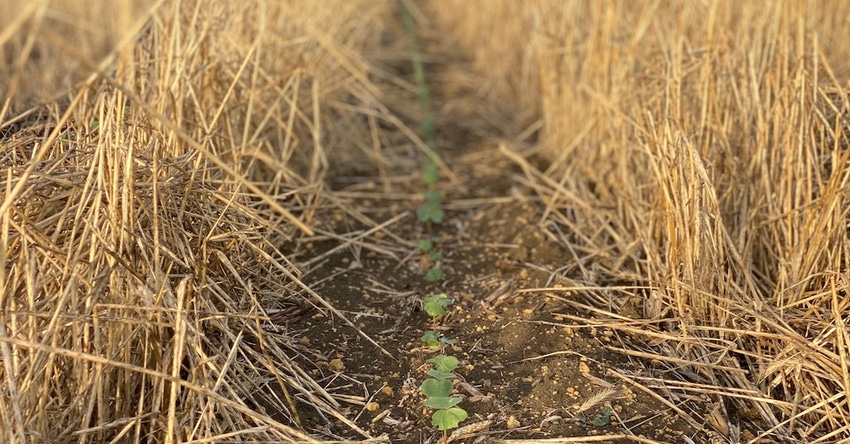
The emerging carbon market is often compared to the Wild West. There is little regulation, a lot of unknowns and potential for both great risk and great opportunity.
“If there is an opportunity, we want to be sure growers are at the front of the line to take advantage of it,” said Jesse Daystar, chief sustainability officer with Cotton Incorporated.
In a recent webinar, Daystar outlined key points growers should consider before making carbon credit decisions.
Payment schedule, contract length
There is great variability in contract length and payment schedule among carbon credit companies. Some companies offer annual contracts, while others, like Indigo Ag and Nori offer five and 10-year contracts, respectively.
“Certainly, long contracts can be risky and that’s something to think about,” Daystar said. “I highly recommend consulting with a lawyer who really knows contracts. You don’t want to sign up for something you might regret later.”
Additionality
Since the goal of carbon credits is to reduce climate impacts, not maintain the status quo, most contracts have a new practice requirement. It’s often referred to as additionality, which means the activity would not have been done if the buyer didn’t ask for it.
“If you’ve already done cover crops, that’s not additional,” Daystar said. “But if you’re considering doing cover crops now and would use the carbon credit money to do it, that qualifies as additional.”
However, Daystar added, if a practice is uncommon in your area and you as a grower are one of the few leaders using that particular climate-smart practice, it could count as additionality.
“It’s all about going above and beyond business as usual,” Daystar said. “So, there may be some disadvantage to being an early adopter of these practices.”
That point has caused heartburn for many producers who have incorporated climate-smart practices on their operations for years but may not be eligible to receive compensation for those efforts.
“Some programs back pay for a period of time — some up to five years in the past — but most early adopters will likely not benefit. That’s unfortunate because for this to work, I think we’re going to need the participation of early adopters.”
Penalties
What happens when a producer must take a temporary break in a carbon credit practice? For example, a no-till field needs to be tilled, or a cover crop does not get planted.
“When you break a contract there can certainly be financial penalties, and those will vary among providers,” Daystar said.
For example, growers contracting with Nori are not bound to any practice plan and are not liable for carbon losses that occur due to unforeseeable circumstances. However, Soil and Water Outcomes, which offers annual contracts, would consider a pause in practice a breach of contract and the farmer would not receive payment.
“That’s something to consider because life happens,” Daystar said. “Maybe you don’t get paid, hopefully you don’t have to pay anything back, maybe those payments resume the following year. There are different ways providers handle this, and it’s definitely something for which growers should be aware. This could be where shorter contracts have the advantage, because when unforeseeable events happen, you’re only losing one year as opposed to 10.”
Permanence
Carbon capture is based on the premise of capturing and storing carbon for a period of time. Storage time for some protocols is 100 years. How will programs verify storage over the time period? Most programs use different rules on permanence.
Third party verification
Practices and outcomes will need to be verified. Over how many years will the verification occur? Who will pay for it — the grower or the provider? How will it fit in with the daily operation? And what will verifiers really be checking? All questions growers should be asking as they consider carbon credit contracts.
“There is much uncertainty about what verification will entail, and again a lot of variability between providers,” Daystar said. “Soil and Water Outcomes requires yearly field visits, or there are opportunities for remote sensing. Indigo Ag is using random visits and evidence checks. Know what you’re signing up for, and be comfortable with the process.”
Carbon price
Daystar cautioned that the quality of the carbon program and credit can influence prices.
“Some credits have a higher verification, some have a lower,” he said. “That will influence price and is something to consider.”
There are also different ways in which programs pay. Some are outcome-based, meaning they will pay for the tons of carbon actually captured in the ground. Others are practice-based. For example, a Bayer program is offering $3 per acre, per year for no-till or strip-till practices and $6 per acre, per year for planting cover crops — allowing growers to earn up to $9 per acre per year when combining these practices.
Current market prices for carbon are roughly $15 per ton, but Daystar said he expects carbon prices will be volatile and likely go up into the future.
“If you lock in at a low price now who might be missing out on an opportunity to get a better price and make more money on your practices,” he added. “Be informed, try it on a select part of your farm, but don’t do the whole farm too early, because I think you’re going to miss out on some opportunities if you do.”
About the Author(s)
You May Also Like






